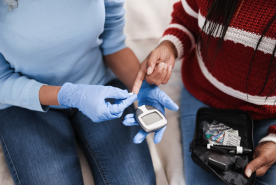Table of Contents
- What causes urinary tract abnormalities to occur before birth?
- What kinds of abnormalities may occur?
- Are there different kinds of blockages?
- Do these blockages always cause kidney damage?
- What happens if the child is born with only one healthy kidney?
- Should urinary tract abnormalities be treated before birth?
- What will need to be done after the baby is born?
- What can I expect for my child?
Ultrasound examinations are often done as part of prenatal care. This test allows the doctor to examine babies before they are born. With ultrasound, the doctor can see the baby's internal organs, including the kidneys and urinary bladder. Occasionally, an abnormality is detected in the developing urinary tract. A doctor can then determine whether treatment is necessary. Parents should know that, in many cases, these abnormalities do not have a major impact on the child's overall health.
What causes urinary tract abnormalities to occur before birth?
In about one of 500 births, some abnormality occurs in the development of the kidneys or urinary tract. It is not really known why this happens. The development of the urinary tract is a complex process that is not fully understood. Problems in the development of the urinary tract that occur before birth are called "congenital.
If you are the parent of a child with kidney or urinary tract abnormalities, you don't have to go through it alone. Join the NKF Parents of Children with Kidney Disease Community.
What kinds of abnormalities may occur?
In some cases, one or both kidneys may fail to develop. In other instances, an abnormality may be present that blocks the outflow of urine. This blockage may cause urine to back up into the kidney, a condition called hydronephrosis, which causes the kidney to appear enlarged on the ultrasound test. Another common abnormality is called reflux. This occurs when a valve-like mechanism at the point where the ureter joins the bladder does not work, allowing urine to wash back up into the kidney.
Are there different kinds of blockages?
Yes. Blockages may occur at the point where the ureter leaves the kidney pelvis, or at the point where the bladder empties into the urethra. These urinary tract abnormalities may be associated with urinary tract infections in children, which can result in kidney injury. However, when detected early and treated appropriately, kidney injury may be avoided in many cases
Do these blockages always cause kidney damage?
No. Before birth, the mother's placenta performs most of the functions of the kidney. As a result, babies with urinary tract abnormalities generally develop normally before delivery. In addition, many kidney or urinary tract abnormalities detected before birth have no major impact on the overall health of the baby following delivery. Nevertheless, certain conditions may interfere with the baby's kidney function or growth after birth. For example, severely blocked flow of urine may damage the developing kidney and result in poor function after birth, a condition called dysplasia. If both kidneys are involved, the amount of urine may be seriously decreased. As a result, there may not be enough amniotic fluid surrounding the fetus, and the baby's lungs may also be affected.
What happens if the child is born with only one healthy kidney?
In cases where only one kidney is affected, the other kidney is usually capable of increasing in size and function to compensate for the abnormal kidney. Children with only one normal kidney still have enough kidney function to grow and develop normally.
What will need to be done after the baby is born?
After delivery, your doctor will examine your baby carefully and request certain tests to find out more about your baby's condition. The baby's blood pressure will be measured using an infant blood pressure cuff. Often, ultrasound of the baby's kidneys and bladder will be done to get a closer look at your baby's kidneys and bladder than is possible before delivery.
Another test that is often done is called a voiding cystourethrogram. In this test, a thin tube called a catheter is inserted into your baby's bladder through the urethra, and the bladder is filled with x-ray dye. The catheter is then removed and x-rays are taken as the baby urinates. This test evaluates the baby's bladder and urethra, and also determines if reflux is present.
In babies who have hydronephrosis, a type of x-ray called a renal scan is often done. In this test, a small amount of radioactive tracer is injected into a vein. This tracer is removed from the blood and excreted by the kidneys. By measuring the time the kidneys take to remove this tracer, the doctor can tell how well the kidneys function and whether there is something preventing them from emptying properly. Renal scans are often done several weeks after birth so that the infant's kidneys have time to begin functioning outside the uterus.
What can I expect for my child?
Babies with urinary tract abnormalities detected by prenatal ultrasound often do very well. Nevertheless, babies with these conditions need careful evaluation following birth to see if treatment is necessary. Your baby may only need periodic visits to your doctor, or a specialist in the treatment of children with congenital urinary tract abnormalities. Sometimes, a dose of antibiotics at bedtime is prescribed. Occasionally, infants with urinary tract abnormalities may need an operation to correct the problem. Your doctor can provide you with further information regarding congenital urinary tract abnormalities.
If you would like more information, contact our Patient Information Help Line, NKF Cares.
© 2015 National Kidney Foundation. All rights reserved. This material does not constitute medical advice. It is intended for informational purposes only. Please consult a physician for specific treatment recommendations.

















